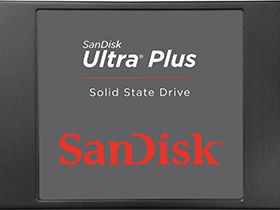SanDisk Ultra Plus SSD Reviewed At 64, 128, And 256 GB
SanDisk's Ultra Plus replaces the company's older SATA 3Gb/s SandForce-based Ultra with something a bit more modern, and with a budget-oriented price tag. We test all three capacities to see if the entry-level pricing belies a pocket rocket in disguise.

SanDisk's Ultra Plus: Ballin' On A Budget
When you manufacture your own NAND, you can apply that special kind of knowledge liberally when the time comes to design your own SSDs. As one application engineer told me, "If I have a question about the flash, I can just walk down the hallway and ask somebody." Less-endowed companies in the storage business don't have that luxury. Sadly, that puts a lot of the really low-level optimization out of reach for much of the SSD industry, which is unfortunate because some of the most interesting developments occur in that flash netherworld these days.
In an adapt-or-die marketplace, some of the solid-state middle class are taking steps to fight back with strategic partnerships, firmware developments, and materials management to keep them competitive with the fabbed oligarchy. There is a shake-up coming, and we've already seen tragic departures from a market deep in the throes of consolidation.
At the end of the day, flash memory is the main ingredient of today's SSDs, and so the companies with their own NAND manufacturing hold most of the cards. As a firm without a fab, you really need some manner of competitive advantage or face the writing on the wall if you're making and selling SSDs. Either that, or hire Don Draper to come up with a wicked marketing strategy.

SanDisk is part of that gentleman's club with access to its own NAND fabrication facilities. Thanks to a joint venture with Toshiba, SanDisk has the manufacturing capabilities to crank out flash. And being a flash-only organization anyway, it has a fairly sassy intellectual property portfolio concerning solid-state storage. If the company's name doesn't resonate with you as an SSD purveyor, that's because most of its drives were historically sold to OEMs. The products we review are mostly part of a smaller retail segment, and for every drive we see, there are dozens more that end up in laptops, desktops, and servers.
Back in the early days, if you bought a laptop with a proper SSD inside, odds were good that it came from SanDisk. Until recently, if you bought a retail SSD, it probably wasn't one of SanDisk's. That's a situation the California-based company hopes to change, thanks in part to its stash of patents, some competitive engineering, and and a generous helping of NAND specialization. It doesn't even believe it needs its own controller. SanDisk does have a proprietary processor, but the first couple of retail efforts employed SandForce's logic. Like several other companies playing the controller field, SanDisk uses several SSD processors to better leverage its other strengths.

SanDisk's Ultra Plus is a fairly good example of that dynamic. Thanks to the company's NAND experience and some firmware prestidigitation, the Ultra Plus comes equipped with something SanDisk refers to as nCache. We first covered this technology in SanDisk Extreme II SSD Review: Striking At The Heavy-Hitters, but essentially, nCache is a system that allows each MLC NAND device to behave like single-level cell flash, resulting in higher performance, lower write amplification, and better endurance characteristics. SanDisk claims the effect is especially helpful with fewer outstanding commands, thus giving the Plus a bit more low-end grunt.
That's especially important as lithography shrinks, and features like nCache could help wring the best longevity from the Ultra's 19 nm Toggle-mode NAND. nCache itself isn't so new, but the technology certainly hasn't been a part of SanDisk's SandForce-based offerings. That controller doesn't allow the freedom to really optimize for deeper NAND integration. Without the ability to tweak every inch of SandForce's firmware, you have to adopt a competing controller (or design your own) to make features like nCache work. Marvell's SSD processors are just the opposite. Whereas with SandForce, you're locked into a firmware package, Marvell's controllers require you to create your own, letting the designer run wild as time and budget constraints permit.
Stay on the Cutting Edge
Join the experts who read Tom's Hardware for the inside track on enthusiast PC tech news — and have for over 25 years. We'll send breaking news and in-depth reviews of CPUs, GPUs, AI, maker hardware and more straight to your inbox.

The Ultra Plus is part of a design that originated from a lesser-known X110 SSD family, seen almost exclusively in OEM applications. At its heart, you'll find a Marvell 88SS9175 "Van Gogh Lite" controller. That particular piece of silicon is very much like the more traditional eight-channel 88SS9174 (used in products like Crucial's m4), except that it exposes just half the channels. The '9175 itself is used sparingly through the industry, residing in a handful of products from Lite-On and various custom applications.
Unsurprisingly, with only four channels to worry about, power consumption drops significantly, if not profoundly. That's fine and well, but drives like Intel's X25-V used half-channel designs too, and performance took a nose dive as a result. So, let's get this straight from the get-go: is SanDisk's Ultra Plus a victim of a silly budget-driven design disaster?
Fortunately, no. The Ultra Plus ships in three capacities: 64, 128, and 256 GB. Each is capable of impressive numbers at the respective size levels, too. We obtained all three to test, so that will be the final judge. But SanDisk ticks most of the feature boxes for a value-oriented drive.
| SanDisk Ultra Plus 2.5" SATA 6Gb/s SSD | 64 GB Ultra Plus | 128 GB Ultra Plus | 256 GB Ultra Plus |
|---|---|---|---|
| Controller | Marvell SS889175-BJM2 | ||
| NAND | 19 nm eX2 ABL (MLC) | ||
| Interface | SATA Revision 3.0 | ||
| Warranty | Three Years | ||
| Seq. Read/Write (ATTO) | 520/155 MB/s | 530/290 MB/s | 530/445 MB/s |
| Random Read/Write (Iometer) | 76/29K IOPS | 80/33K IOPS | 82/39K IOPS |
| Weight | 38 g | 39 g | 40 g |
| Die Count | 8 | 16 | 32 |
| Street Pricing | $65 | $95 to $99 | $165 to $175 |
The first thing we notice is that those sequential read and write specifications aren't what we'd expect from a budget drive. The 64 GB model sports numbers that any ONFi-based 60/64 GB SSD should envy, while the 256 GB can conceivably write at a crushing 445 MB/s. Four-kilobyte random reads are quite spry as well, starting out at 76,000 IOPS for the junior member and escalating with die count. The only hint we get from the spec table that this SSD's origins are more humble than some of the newer high-end SSDs is comparatively lower 4 KB random write performance. Perhaps it all depends on how you're testing the drive.
SanDisk's 64 GB Ultra Plus currently sells for just north of $1/GB. That makes it about even with the most affordable 64 GB drives on the market, though availability isn't as robust as the two larger Plus models. The 128 and 256 GB capacity points are far more competitive online, and sale pricing can tip the value scale substantially in any one model's favor. It helps that there isn't much retail packaging to get in the way, since the box's contents are limited to the SSD, a 7 mm-to-9.5 mm spacer, and a short multi-language guide.

Current page: SanDisk's Ultra Plus: Ballin' On A Budget
Next Page Dissecting SanDisk's Ultra Plus SSD-
kevith I have had the former SanDisk Extreme 128 GB for a year now, and it´s definitely fast enough. But what´s more impressive is, that after a year, the write amplification still hovers between 0,800 and 0,805. I´m using it in my laptop for quite "normal" use, FB, YouTube, mail, wordprocessing etc.on Windows 8 64-bit. So far it has served me very well, my next SSD is going to be another SanDiskReply -
Soda-88 I recommended this SSD (256GB) to my friend just a week ago since it was nearly as cheap as top of the line 128GB SSDs, glad to read positive review.Reply -
alidan im honestly looking into ssd drives for games and mass small file storage.Reply
these are cheap, and they are large, would definitely help with load times/game performance, and browsing images stored enmass. -
Brian Fulmer I ordered 5 Extreme 128GB drives in March (model SDSSDHP-128G). I've been using OCZ, Kingston, Samsung and Crucial drives in every desktop and notebook I've deployed since August 2013. Out of ~75 drives, I've had 1 bad Vertex 4 and 6 defective by design Crucial V4's. Of the 5 SanDisks, 2 failed before deployment. Support was laughably incompetent in demanding the drives be updated with the latest firmware. Their character mode updater couldn't see the drives, because they DIED. SanDisk is no longer on my buy list.Reply
Incidentally, of the 8 SSD model SSD P5 128GB, I've had one die. The context should be of 35 Vertex 4's, I've had one die. I've had zero failures with 15 840's despite their supposedly fragile design. -
ssdpro Brian Fulmer's comments are very reasonable (except the "deployed since Aug 2013" part lol). Way too many people experience a failure then scream all drives from that mfg are junk. I have owned 2 840 Pro drives and had one fault out. Does that mean Samsung drives have a 50 percent failure rate? For me, yes, but overall no and I am definitely not that naive. The 840 Pro can and do fail like anything electrical can. I have owned probably a dozen OCZ drives and had one Vertex 2 failure - does that mean OCZ/SandForce firmware stinks and they aren't reliable? No, it just means a drive died and who knows why. I have owned a couple SanDisk products and none failed. Does that mean SanDisk is the best? No... it just means I didn't have one die but I also only sampled 2.Reply -
Combat Wombat These and the OCZ drives from newegg are looking mighty close in price!Reply
BF4 Rebuild is about to take place :D -
@ssdpro: spot on. sure, if i buy from vendor a and his product fails, i will probably not buy from him again. if it fails more than once, there is no chance i'll buy his stuff again and i also will warn others about it. but understandable as this is, in the end even that doesn't mean much about the reliability of the manufacturer.Reply
that's also why i'm a bit sceptical about product ratings on amazon and the likes, since people are more inclined to complain about a bad experience, than share their view on a product that simply does what it should do: work.
what we would need more often are statistics from bigger companies, or even repair services, so we don't have to base our purchases on samples of a few dozen to a few hundreds, but on thousands upon thousands of cases. -
flong777 The 840 Pro still appears to be the fastest overall SSD on the planet - but the difference between the top 5 is pretty much negligible. Among the top five, reliability and cost become the determining factors.Reply -
anything4this I don't understand the ~500MBs read limit on the drives. Is it an interface bottleneck?Reply
Most Popular

